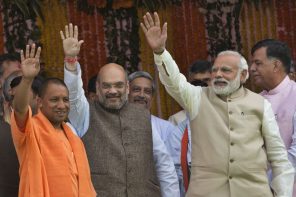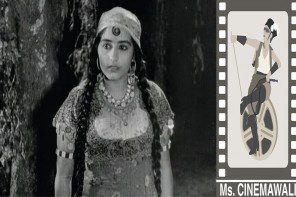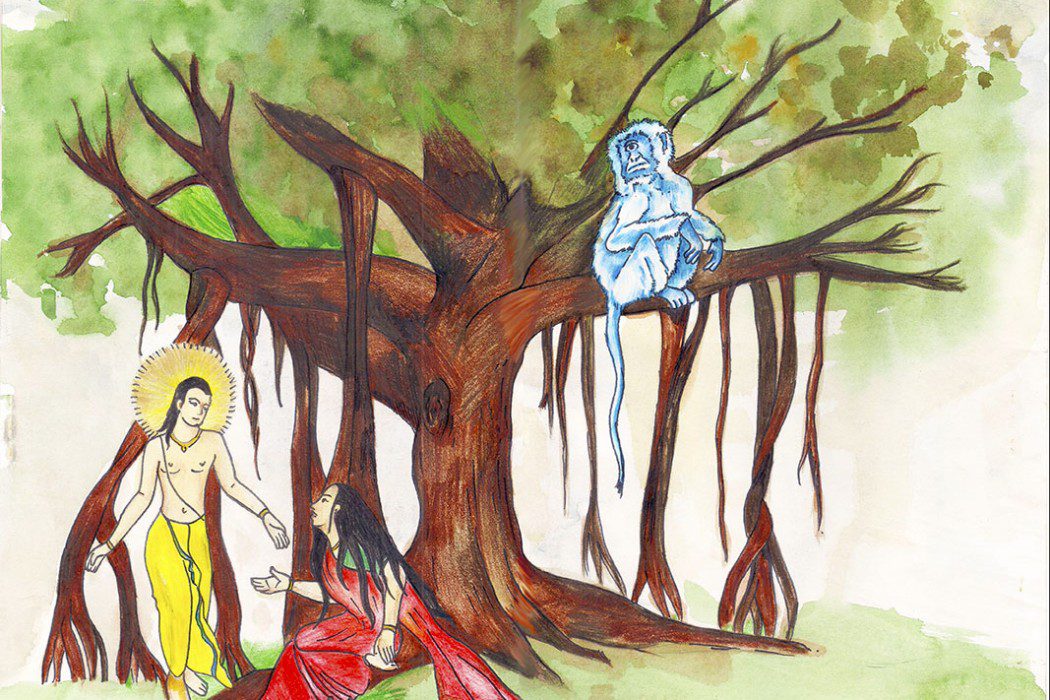Manjiri Indurkar goes back to our myths to trace how the past and the present collide to give a kind of timelessness to patriarchy.
A few weeks back, while at a café, I came across Suniti Namjoshi’s The Fabulous Feminist. In a sea of management and the hundred-rupee-fiction books, it was the only saving grace, and so I picked it up and began reading it. The book, a collection of short stories and fables, looks at the mythological tales from a feminist perspective. From Indian mythology to the Greek one, these stories are written with wit and sarcasm. I ended up reading almost half the book that day, and I soon placed an order for it, I had to find out what Namjoshi had to say about the literary heroines of our world.
As I write this piece, I find the one-eyed monkey, a traveler and a survivor, who often appears on the pages of this book, staring at me. The one-eyed monkey gives me a puzzled look. With one hand scratching her head and the other one resting on a tree branch she tries to make sense of the series of events that unfolded in front of her one good eye. She was the sole witness of the rape of a famous woman sage. She watched the sage she so respected get raped by Indra, the king of gods. And also saw Indra flee the site as the sage’s husband, an even more famous Brahmin, entered the scene. When the husband, on realising how he has been wronged, summoned lord Vishnu, the god asked the one-eyed monkey to narrate the incident truthfully. The monkey did the best she could in making a case for the sage. As should have happened, Indra was called in the court of the Lord and asked to pay for his crimes. He needed to be freed of his sins, said Vishnu. He will have to make a sacrifice, a stallion had to be killed, he said. “And so it came about that a horse was killed, a god purified, a Brahmin appeased, a woman ruined and a monkey left feeling thoroughly puzzled.”
This narrative appears to be a retelling of the Ahalya legend from Ramayana. Ahalya, the most beautiful woman in the world, was created by Lord Brahma as an answer to Urvashi’s (the foremost celestial nymph) pride in her beauty. Ahalya was raped by Indra who came in the form of her husband Maharishi Gautama. When the Maharishi came to know about his evil doing, he cursed Indra and as a result the god lost his genitals, and then he cursed his wife for not recognising her husband from another man. He turned her into a stone. Later, in a bid to rectify his “mistake”, he told her that his curse would be lifted by the brush of Lord Ram’s foot. But since Ram came after almost 60,000 years, the woman sat as a stone, biding her time, burning under the harsh Sun, but it did not matter for she was just a stone.
The Ramayana has always been thought of as the ideal book that teaches men but more importantly women, the way of life. So you have a Ram who chose ‘raj dharma‘ (his role as a king) over his role as a husband and forsook Sita. And you have Sita who chose ‘patni dharma’ obediently and left for the jungle when abandoned by her husband. And so Ahalya, in such a setting, becomes a wonderful metaphor for women. Their hearts should be made of stone, they must not beat at the sight of a man or woman; they should let themselves be kicked around by their husbands, but not demand sex. They should be able to avert such thoughts and be devoted to their husbands.
What must be noted, though, is that this isn’t the only version of the Ahalya story. Much like the Ramayana which changes its course with geography, the Ahalya story too gets modified. As many would know, Valmiki’s Ramayana isn’t the only one known to exist. There is a Tamilian Ramayana and a Telugu one, and then there is an Uttarakhandi, and an Indonesian one and so on. Interestingly, the oldest version by Valmiki, often perceived to be the most idealistic of all texts, gives us, what in my opinion, is a seemingly progressive version of Ahalya’s story. In his version, Ahalya recognises Indra and yet goes ahead and makes love to him, to satiate her sexual curiosity.
The tale of her rape by Indra is something we all have seen on television; it is a rather dull and simple narrative of a complex text. In the story titled Further Adventures of the One-Eyed Monkey, Namjoshi puts herself and/or her reader in the position of the one-eyed monkey. The monkey, perhaps, a symbol of a unilateral view, is the one whose perspective we see. And therefore all we get is the feeling of bewilderment. How is this justice, the one-eyed monkey wonders, how can the sacrifice of a stallion undo the act of rape. How was the man, the sage’s husband, wronged in this act? Who was this stallion whose life they just sacrificed? Another ‘dalit’, another lesser being, who could stand to lose his life in order to save that of a superior being?
Namjoshi never really points out that this is Ahalya’s story. Therefore, one can only guess. But every story where the woman is made to pay for the choices she made and the ones she did not, becomes Ahalya’s story, doesn’t it? This got me wondering, what would the one-eyed monkey’s narrative be if she were to witness the many versions of Ahalya’s story? Would she judge her harshly when she would see her give in to her sexual curiosity? Would she weep at the sight of Ahalya’s rape, her turning into stone? I wanted to know. And so I decided to put her in every story and ask her what she saw. What she made out of the stories of Ahalya, the foremost of the Panchakanyas (the five virgins — Ahalya, Draupadi, Sita or Kunti, Tara and Mandodari). And so began the ‘further’ adventures of the one-eyed monkey where she witnessed the various methods in which a woman was punished no matter what she did, no matter who she chose.
Further Adventures of the One-Eyed Monkey
Story I:
(Taken from the Uttara Khanda which was a later addition to Valmiki’s Ramayana)
Brahma creates Ahalya out of pure creative energy. Brahma gives her to Gautama Maharishi to raise her till puberty. When she hits puberty Gautama returns her to Brahma. Brahma says he is pleased with his self-restraint and ‘gifts’ her to Gautama. Brahma does not ask Ahalya what she wants and gives her away to an aged man who lives in a jungle. Indra, who thinks anyone this beautiful should be his, is jealous of Gautama. And so he takes his form and hatches a plan of making love to Ahalya, the woman whose husband does not wish to have sex with her till her ‘fertile period’ arrives. “Those craving coitus cannot wait till the fertile period. I crave union, slim-waisted one!” says Indra and she gives in to the curiosity. The curiosity of a mortal woman, craving for a celestial being, a mortal woman unsatisfied by her aged husband, a mortal woman who awaits gratification. She is a rebel, a free-spirited woman, she knows how to make and break her boundaries, she isn’t afraid of exploring her sexuality and embracing it. Now Gautama arrives as Indra, in the form of a cat, leaves. And he asks the woman who that was. She truthfully answers maajra (a cat or my lover). And the husband, the ‘wronged’ one, the one who did not care much for her sexual desires, for her needs and wishes, punishes her in the cruelest way. He asks her to stay hidden in the terrible forest, to sleep on ash and survive on air, and asks her to wait for Ram, for he shall be her redemption from her curse. The woman complies and lives in exile for 60,000 years.
Story II:
(Taken from Venkata Krishnappa Nayaka’s Telugu rendition of the story)
Brahma creates Ahalya with everything beautiful in world. And she falls in love with Indra, but as is the tradition she is given away to Gautama without consent. He wins her in a contest, fair and square. Indra, who longs for her as well, visits her often. And they flirt and chat merrily when Gautama is away. Longing for sex, when she expresses her desire to Gautama, who she sees as Indra, her lover, he refuses saying it isn’t her fertile period. As if the woman is just to bear children! Agitated, she longs for Indra, who assumes the form of Gautama and satisfies her sexual cravings. Upon getting caught, she is punished severely for having sexual desires and for being an infidel and she lives a life worse than death, until her saviour Ram ‘liberates’ her from the curse.
Story III:
(Taken from Brahma Vaivarta Purana)
Indra comes as Gautama and rapes an unsuspecting Ahalya. She is then turned into a stone for her inability to recognise her husband. And is given her life back by the brush of Ram’s foot.
The various versions of Ramayana offer various perspectives of the story, however, in all the stories she is redeemed by Ram who made his own wife sit for the ‘agni parikhsha’. Maharishi Gautam, who punishes his wife meets with no criticism and Ahalya is hailed as the greatest ‘pativrata‘ (obedient wife) woman. No one asks Ahalya about her wish, did she choose to be obedient or was obedience forced on her. Then, I wonder, won’t it be safe to assume that mankind has only become more regressive over the time. Valmiki at least let Ahalya have her way. She slept with Indra out of her own wishes, she wasn’t tricked into it and she certainly wasn’t raped. In the later versions like the Brahma Vaivarta Purana, she is raped, and it is done in the name of absolving her of her guilt. But the question that needs to be asked is: was she really feeling guilty? How can someone else decide for her? And have things really changed since then? Aren’t we still fighting the same battles? A few days back a Samajwadi Party minister was found saying that women who get raped should be punished along with the rapists. And that is the modern day Gautama for you, punishing women for being born with vaginas.
When the one-eyed monkey came back from her journey, she was rather distraught. After travelling for years and years, when she returned it was a different time altogether and at first she seemed hopeful, she thought that life should have become better. Look at all these women living alone, roaming the streets with no husband in tow. But eventually she realised that it wasn’t a lot different. The many faces of the beautiful Ahalyas were still getting raped and murdered. They were raped for choosing to be out late in the night, and for wearing short clothes. They were raped for drinking alcohol and for indulging in adultery. They were even raped when they followed the norms of patriarchy and for defying them. They were raped when they married men, and they were raped when they chose not to. They were raped because they belonged to a lower caste and when they belonged to an upper caste. And they were blamed for their own tragedy. Who asked them to be born this way?
And then one day came the news of two young girls found hanging to a mango tree, in the state that once was rule by the same Ram who, each time, became Ahalya’s salvation. And so the one-eyed monkey went back to her tree and decided to write a book, an autobiography, the story of the monkey’s various experiences. I heard that after a lot of struggle, it has finally been published. I congratulated her on her achievement. But she isn’t happy, it is no more her story, she says. It has been altered. “I do not recognise myself in it,” she says. But her publishers beaming corner to corner pat her back (touch her inappropriately) and say “Art transforms.”















Arti
Feels like a strong cup of coffee- slapped me awake. Thank you.